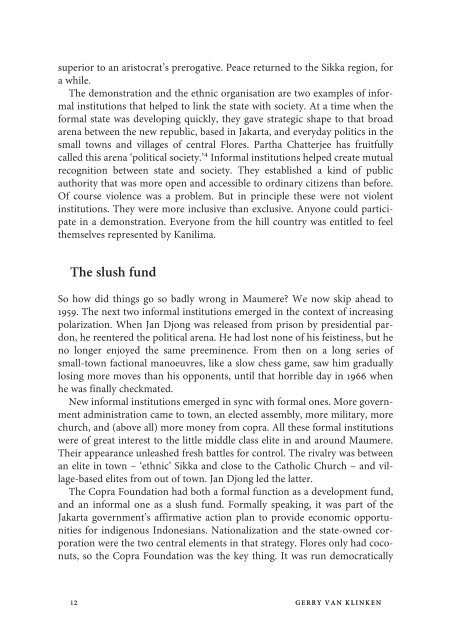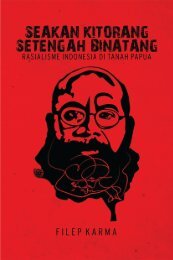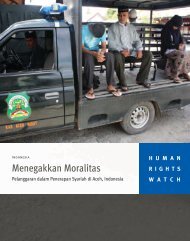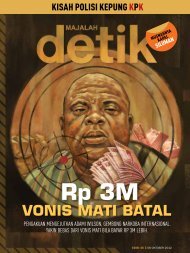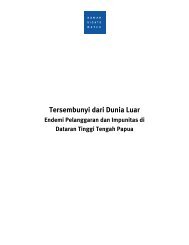Postcolonial Citizenship
PDF-6104Weboratie_Van_Klinken_-_DEF
PDF-6104Weboratie_Van_Klinken_-_DEF
You also want an ePaper? Increase the reach of your titles
YUMPU automatically turns print PDFs into web optimized ePapers that Google loves.
superior to an aristocrat’s prerogative. Peace returned to the Sikka region, for<br />
a while.<br />
The demonstration and the ethnic organisation are two examples of informal<br />
institutions that helped to link the state with society. At a time when the<br />
formal state was developing quickly, they gave strategic shape to that broad<br />
arena between the new republic, based in Jakarta, and everyday politics in the<br />
small towns and villages of central Flores. Partha Chatterjee has fruitfully<br />
called this arena ‘political society.’ 4 Informal institutions helped create mutual<br />
recognition between state and society. They established a kind of public<br />
authority that was more open and accessible to ordinary citizens than before.<br />
Of course violence was a problem. But in principle these were not violent<br />
institutions. They were more inclusive than exclusive. Anyone could participate<br />
in a demonstration. Everyone from the hill country was entitled to feel<br />
themselves represented by Kanilima.<br />
The slush fund<br />
So how did things go so badly wrong in Maumere? We now skip ahead to<br />
1959. The next two informal institutions emerged in the context of increasing<br />
polarization. When Jan Djong was released from prison by presidential pardon,<br />
he reentered the political arena. He had lost none of his feistiness, but he<br />
no longer enjoyed the same preeminence. From then on a long series of<br />
small-town factional manoeuvres, like a slow chess game, saw him gradually<br />
losing more moves than his opponents, until that horrible day in 1966 when<br />
he was finally checkmated.<br />
New informal institutions emerged in sync with formal ones. More government<br />
administration came to town, an elected assembly, more military, more<br />
church, and (above all) more money from copra. All these formal institutions<br />
were of great interest to the little middle class elite in and around Maumere.<br />
Their appearance unleashed fresh battles for control. The rivalry was between<br />
an elite in town –‘ethnic’ Sikka and close to the Catholic Church – and village-based<br />
elites from out of town. Jan Djong led the latter.<br />
The Copra Foundation had both a formal function as a development fund,<br />
and an informal one as a slush fund. Formally speaking, it was part of the<br />
Jakarta government’s affirmative action plan to provide economic opportunities<br />
for indigenous Indonesians. Nationalization and the state-owned corporation<br />
were the two central elements in that strategy. Flores only had coconuts,<br />
so the Copra Foundation was the key thing. It was run democratically<br />
12 GERRYVANKLINKEN


